The best immersive experiences USA travelers should visit in 2025 include Meow Wolf (Santa Fe, Las Vegas, Denver, Houston), Superblue Miami, and City Museum St. Louis. These top-tier interactive art experiences blend digital technology, tactile sculpture, and narrative mystery. Key destinations also include Otherworld, AREA15, and WNDR Museum. When planning, consider ticket prices, family friendly interactive art options, and availability of sensory friendly hours.
Surprising fact: some venues span more than half a million square feet—City Museum St. Louis is a 600,000-square-foot “world’s biggest jungle gym,” while Superblue Miami fills 50,000 square feet with art and play.
Whether you are planning a cross-country road trip or just searching for immersive art museums near me, we’ll guide you with a practical roadmap so you can pick the right place to visit today without wasting time. Expect clear notes on starting ticket prices, typical hours on-site, and what makes each spot worth your visit.
This section turns passive browsing into action. You’ll learn how creators use light, sound, sensors, and the occasional machine effect to shape perception. We simplify concepts so you can adapt ideas for your next project or social media course.
Key Takeaways
- Large venues can offer very different draws—know what each excels at before you go.
- Check starting prices and expected hours to plan your visit efficiently.
- Focus on shareable moments that drive media buzz and word-of-mouth.
- Note recurring design concepts you can borrow for a creative project.
- Use this short guide to choose the best immersive experiences USA travelers are talking about in 2025.
Why Interactive Experiences Matter Today
More venues now ask you to act, not just look, and that shift matters for brands and creators.
From passive viewing to active participation
You move from watching to doing. That change makes moments stick. People who touch reactive walls or solve spatial puzzles form stronger memories than those who only observe.
How immersion drives memory, engagement, and social sharing
Designers mix simple elements—responsive lighting, directional sound, and tactile props—to guide attention and reward curiosity.
- Short, clear flows respect people’s time and increase completion rates.
- Small triggers and story cues help first-time visitors feel safe to engage.
- Well-planned tech supports one action per beat so no one feels lost.
| Element | Why it works | Typical technology |
|---|---|---|
| Responsive lighting | Guides focus and mood | Projection mapping, LEDs |
| Directional audio | Creates spatial cues | Spatial audio systems |
| Tactile props | Encourages touch and play | Sensors, low-tech fixtures |
“The best activations invite a single clear action and leave people smiling.”
Tip: plan how visits will look on phones without breaking immersion. If you do, guests stay longer and share more across media.
Interactive Experiences
Design that moves people works on three levels: a responsive environment, multisensory design, and a clear narrative. Start by writing one sentence that defines the guest’s role. That sentence keeps every choice focused.
Tools venues use include projection mapping, LED arrays, motion sensors, and spatial audio. These systems layer to form an immersive experience that reacts to presence and choice.
When you create interactive beats for a project, follow a simple arc: arrival, discovery, reveal. Place interactive elements that reward curiosity at each step.
Keep tech invisible. Hide hardware so the machine logic feels magical rather than mechanical. Prototype complex concepts in a small bay first to save time and budget.
- Pair sight with sound or scent to anchor a moment.
- Define one clear action per beat so visitors never feel lost.
- For families, layer difficulty so kids trigger simple effects while adults find deeper layers.
“The best activations invite a single clear action and leave people smiling.”
Practical note: large-scale installations need sightlines and light-led wayfinding. Use minimal text and let the design guide the flow.
Superblue Miami: Large-Scale Installations That Bend Reality
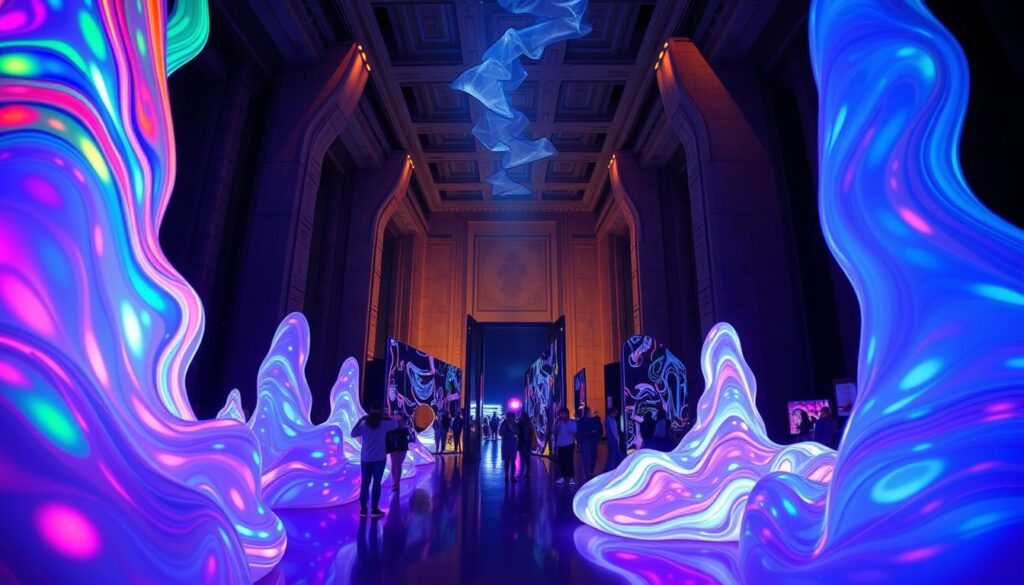
At Superblue Miami, vast rooms and bold installations bend sight and scale so your sense of reality shifts. Ticket prices Superblue Miami start at $29, but options vary by date.
Where it lives: a 50,000-square-foot warehouse filled with art by renowned artists. There’s an add-on for Massless Clouds Between Sculpture and Life if you want tactile access to a memorable moment.
Plan your visit. Start in the mirrored labyrinth to prime your senses. Then move to the Ganzfeld light field to let depth cues recalibrate. Give yourself time to pause; many rooms reward slow looking.
- Massless Clouds is worth the upgrade for photos and one-of-a-kind touch moments.
- Hidden machine work keeps effects feeling magical while staff guide flow gently.
- Not in las vegas, but the scale rivals major destination venues.
| Highlight | Why it matters | Visitor tip |
|---|---|---|
| Mirror labyrinth | Primes perception and offers endless photo angles | Start here to tune your eyes |
| Ganzfeld light field | Challenges depth and resets visual cues | Pause between rooms to let your vision adapt |
| Massless Clouds | Tactile, dreamy layer that photographs beautifully | Book add-on for access and quieter moments |
“Come with a flexible plan; you may find a lot of joy in returning to earlier rooms once your eyes adapt.”
Quick note: Superblue’s curation favors art that asks you to do more than watch. If you’re taking a course on designing for attention or testing a new project, you’ll learn a lot from how scale and subtle tech shape time and life in each room.
Meow Wolf’s Multiversal Worlds: From Santa Fe to Denver and Las Vegas
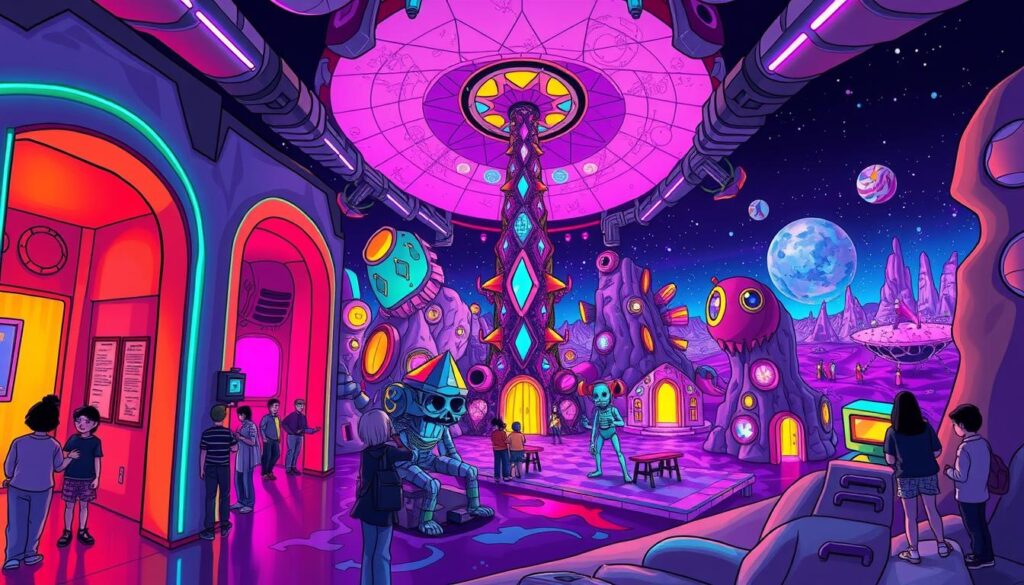
Step into Meow Wolf’s layered worlds and expect each shelf, door, and aisle to hint at a hidden realm. The collective runs major sites in Santa Fe, Denver’s Convergence Station, Houston, and Las Vegas.
Omega Mart in Las Vegas features work by over 300 artists and designers. Ticket prices Meow Wolf generally start around $35. What looks like a surreal supermarket opens into portals and narrative rooms.
In the debate of Meow Wolf vs Superblue, choose Meow Wolf if you want a dense, story-driven scavenger hunt, and Superblue if you prefer ethereal, large-scale light art.
- Follow clues: product labels and signage hide story beats that make you become part of the plot.
- Plan a flexible route; the most memorable installations are often behind “employee only” doors or in everyday fixtures.
- Bring comfy shoes—this is a multi-hour project if you want to see details and sound design that deepen the world.
Why Meow Wolf works: hundreds of artists and designers collaborate so styles shift room to room while the whole world feels cohesive. You can focus on the main arc or free-roam; either way, the place rewards repeat visits.
“You become part of the story as artifacts, characters, and clues nudge you toward deeper mysteries.”
Otherworld: Tech-Forward Art Playgrounds in Columbus and Philadelphia
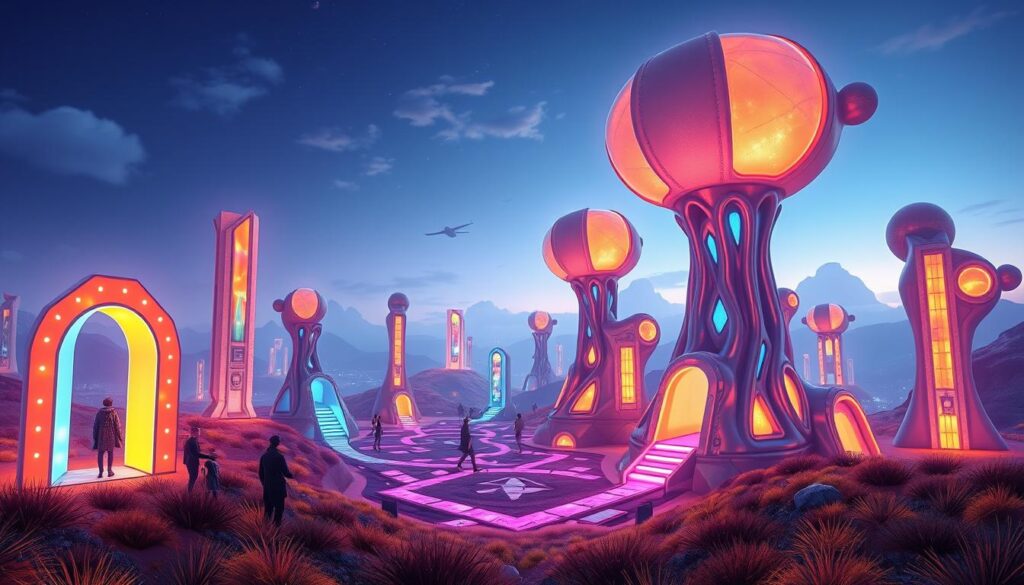
Otherworld’s rooms let you push, poke, and wander—each area mixes retro charm with modern technology. It is a fantastic destination for family friendly interactive art, where kids can safely explore responsive environments.
In Columbus and Philadelphia, Otherworld hosts immersive art that blends practical props and sensor-driven elements.
The Philadelphia site centers on a willow tree sculpture. It uses over two miles of dense LED displays to form a glowing canopy that reacts as you move.
- You’ll find tactile sculptures, hidden crawl spaces, and projection-lined corridors that keep kids and adults engaged.
- Staff encourage low-pressure play, so hesitant visitors feel safe to test and learn.
- Artists rotate new rooms over time, so repeat visits reveal fresh work.
| Feature | Why it matters | Visitor tip |
|---|---|---|
| Willow LED canopy | Creates a living anchor for exploration | Move slowly to watch light react |
| Tactile sculptures | Encourage touch and discovery | Bring children or hands-on tests |
| Projection corridors | Layer mood and narrative without words | Backtrack to catch missed details |
Plan: give yourself a few hours. The sprawling layout rewards wandering and backtracking. If you’re studying a project design or scouting displays, Otherworld is a practical model for blending art, sensors, and behavior.
AREA15, Las Vegas: A Hub of Alternate Realities
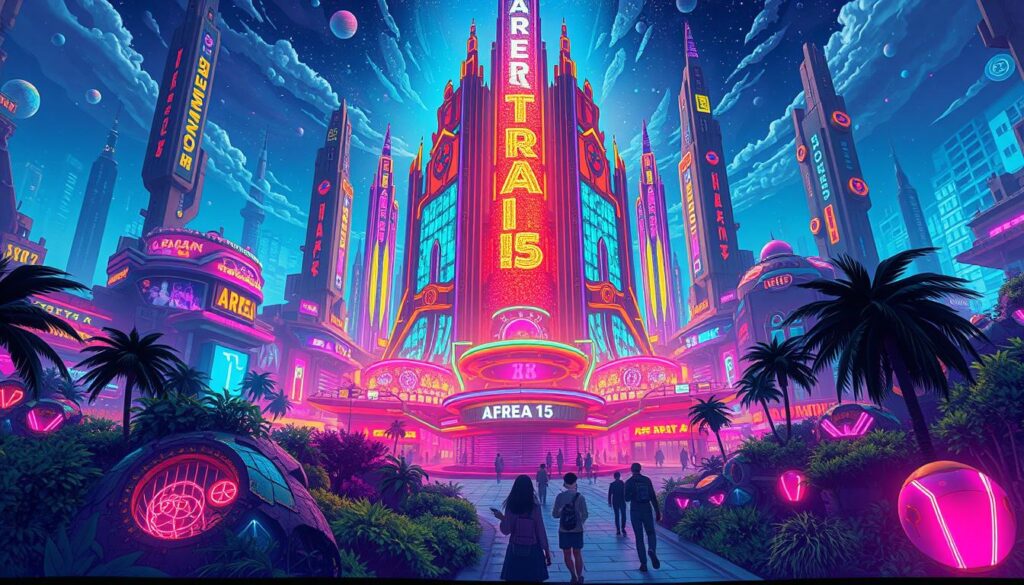
AREA15 puts multiple reality-bending attractions in one place, so you can build a visit that fits your group.
What to expect: rotating alternate rooms and sense-altering rides sit under one roof. Ticket prices vary by attraction, typically from about $32 to $160. That makes it easy for groups to split up based on taste and budget.
- Think of AREA15 as a one-stop place where everyone finds something to love without compromise.
- Check the calendar and bundle tickets to match events and save money.
- Pick one anchor attraction, then fill the edges with shorter installations and quick rides.
- Stagger start times so your group reconvenes for shared moments like a show or pop-up slot.
Practical tips: weekday afternoons have smaller crowds. Wayfinding is strong, so you won’t feel lost even as visuals escalate. Pair your visit with on-site dining to turn a visit into a full night out.
“Keep an eye out for limited-time installations—they can vanish as fast as they arrive.”
WNDR Museum: Become Part of the Art
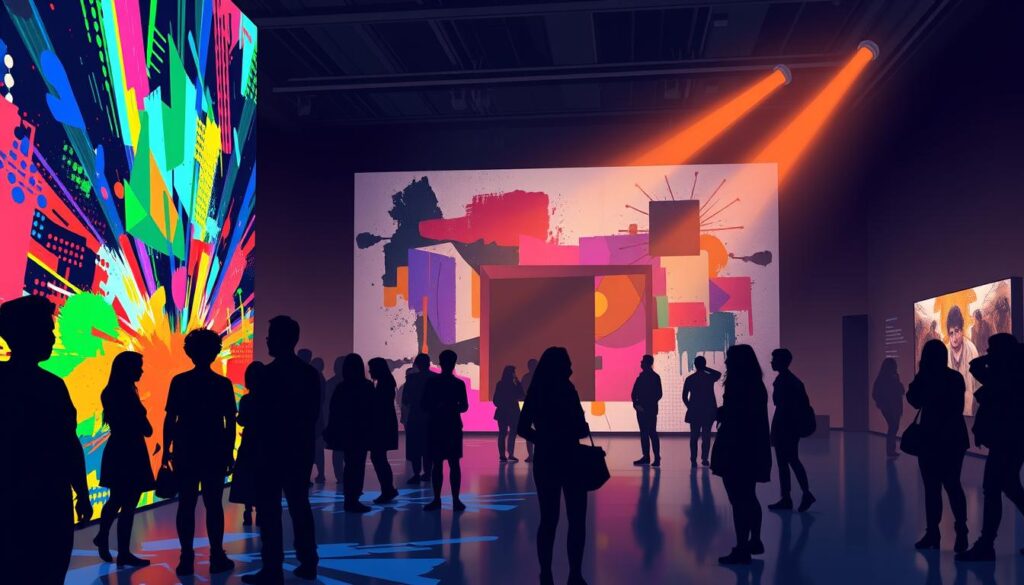
The WNDR Museum asks you to add your presence to the art on display. You’ll find sites in Chicago, San Diego, and Seattle. Ticket prices WNDR Museum start around $32.
What to expect: colorful light displays react when you lie on a responsive floor. Small gestures—shifting weight or stepping—can ripple across a room-wide canvas.
WNDR lowers the barrier for visitors who usually keep their hands to themselves. Clear cues and friendly staff make it easy to try something new without pressure.
- Interactive elements focus on clarity so you always know what to do next.
- Families benefit from quick rooms and a few longer dwell zones for deeper play.
- If you’re shooting content, scout vantage points for the widest light patterns.
| Feature | Why it matters | Visitor tip |
|---|---|---|
| Reactive floor | Teaches the language of interaction in seconds | Try lying down to trigger wide light changes |
| Clear prompts | Reduces hesitation for first-time participants | Follow simple marks or arrows to start |
| Gift area | Artist collaborations extend the visit | Budget time to browse for unique souvenirs |
“Small actions here create big, shareable moments.”
Paradox Museum Miami: Optical Illusions for Every Visitor
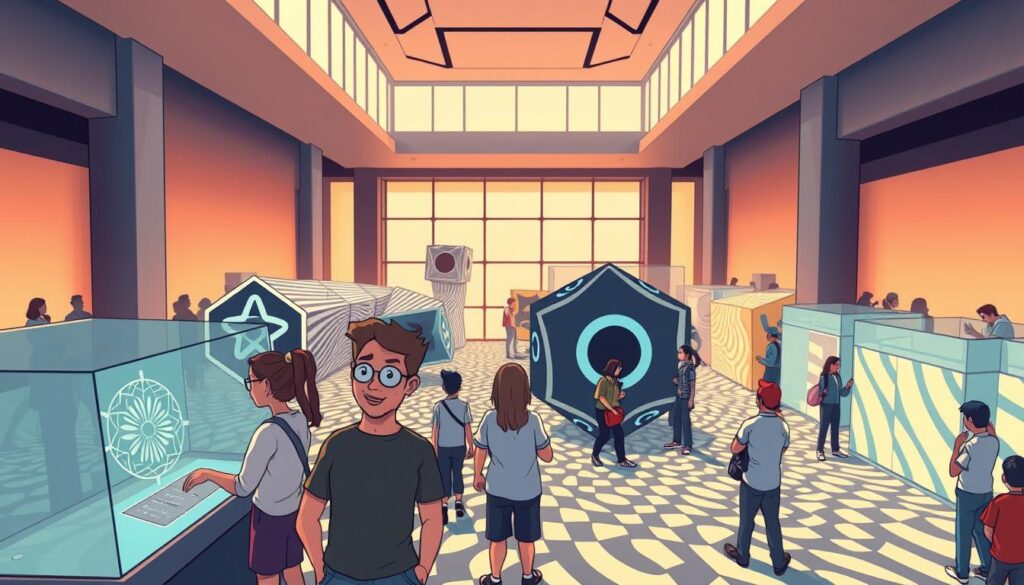
Paradox Museum Miami folds your sense of scale into playful optical tricks that photograph brilliantly. The venue occupies about 11,000 square feet and hosts roughly 70 exhibits that warp perspective and surprise the eye.
Photo-ready highlights: the Zero Gravity Room and multiple upside-down spaces create those eye-popping shots people love to share.
Photo tips and what to expect
- Plan your route around the Zero Gravity Room and the upside-down dining scene for the best shareable moments on social media.
- Use burst mode for mid-air jumps and staged “floating” poses to cut retakes.
- Most setups take under two minutes per group, so lines move fast and the tone stays playful.
- You don’t need special gear—your phone camera and high-contrast backdrops will do the work.
- The approach mirrors illusion museums you might see in new york; staff can even help you frame shots if you ask.
“Arrive near opening to hit popular rooms before crowds build.”
City Museum, St. Louis: The World’s Biggest Jungle Gym Goes Immersive
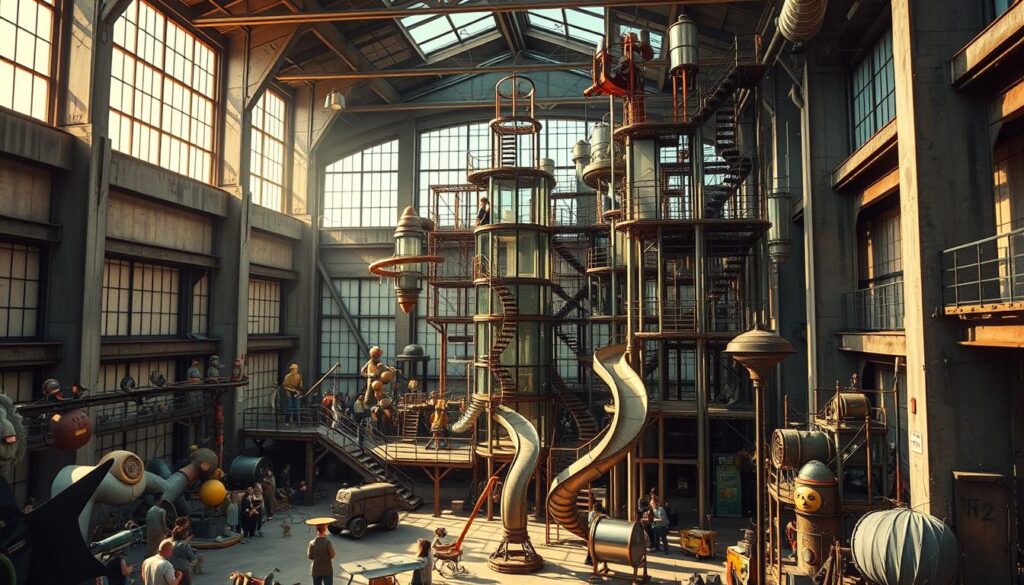
City Museum’s 600,000-square-foot space feels like a city-sized playset. Built by about twenty artists, it stitches reclaimed items into bold installations that invite you to climb, crawl, and discover.
Think of this place as part museum, part playground. People move through sculpted tunnels, slides, and the spooky Enchanted Caves. Tickets start around $20, and plan on several hours to really explore.
- Wear flexible clothing and closed-toe shoes; large-scale installations demand movement.
- Bring water and set rendezvous points—there’s a lot of activity and a lot of space to split up.
- Use the rooftop for a reset and a sweeping view when you need quiet time.
- Bring a small flashlight for deeper cave details and the best close-up looks.
| Feature | Why it matters | Visitor tip |
|---|---|---|
| World’s largest jungle gym | Endless climbing and play | Arrive early to beat lines |
| Enchanted Caves | Spooky, tactile passages | Combine with outdoor structures for contrast |
| Found-object architecture | Breathes life into industrial pieces | Wear durable clothes; expect to get close |
“It’s a place where you can lose track of time in the best way—embrace the wander.”
Wonderspaces: Traveling Interactive Art Across U.S. Cities
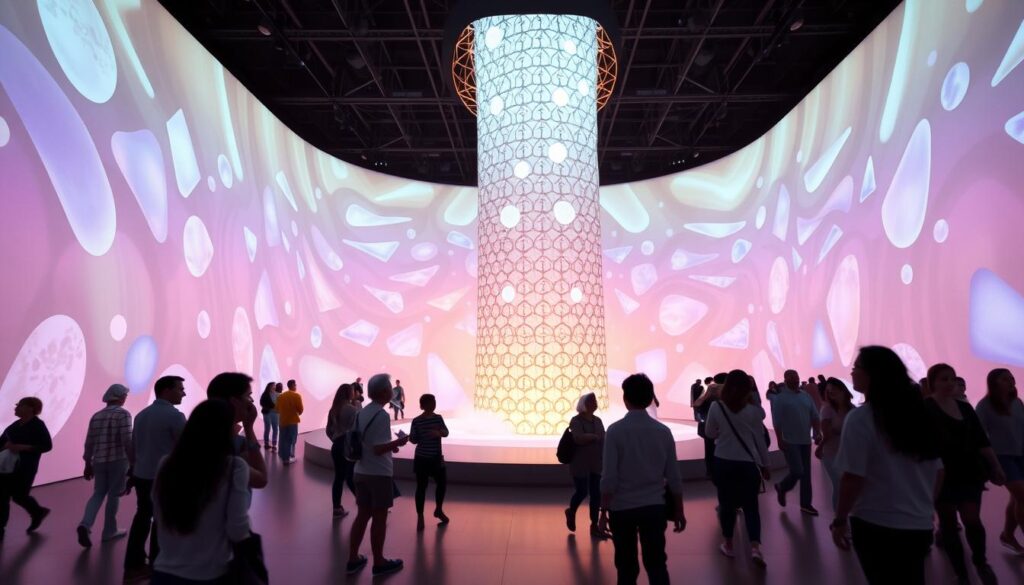
For a compact taste of leading artists and media work, Wonderspaces packs high-quality installations into walkable urban spots.
What you get: rotating, gallery-grade work from more than 100 artists that tours cities like San Diego, Austin, and Scottsdale.
The Scottsdale site runs year-round inside Fashion Square and pairs art with signature cocktails. That makes it an easy place for a date or a team night.
- Perfect if you want top-tier art without flying across the country.
- Lineups change by season, so memberships and repeat visits pay off.
- Exhibits arrive production-ready, which keeps quality steady across each place.
- Staff give gentle guidance so visits balance reflection and play.
If you’re scouting ideas for your own project, note how scale adapts to mall footprints and small galleries. Read placards to learn about sensor placements and media techniques.
Pro tip: visit weekdays for cleaner shots and fewer crowds. Wonderspaces is a strong bridge for newcomers moving from traditional galleries into more hands-on formats.
“Wonderspaces makes curated work easy to find and simple to enjoy.”
Seismique, Houston: A Galaxy of Glow and “Mind-Bending” Rooms
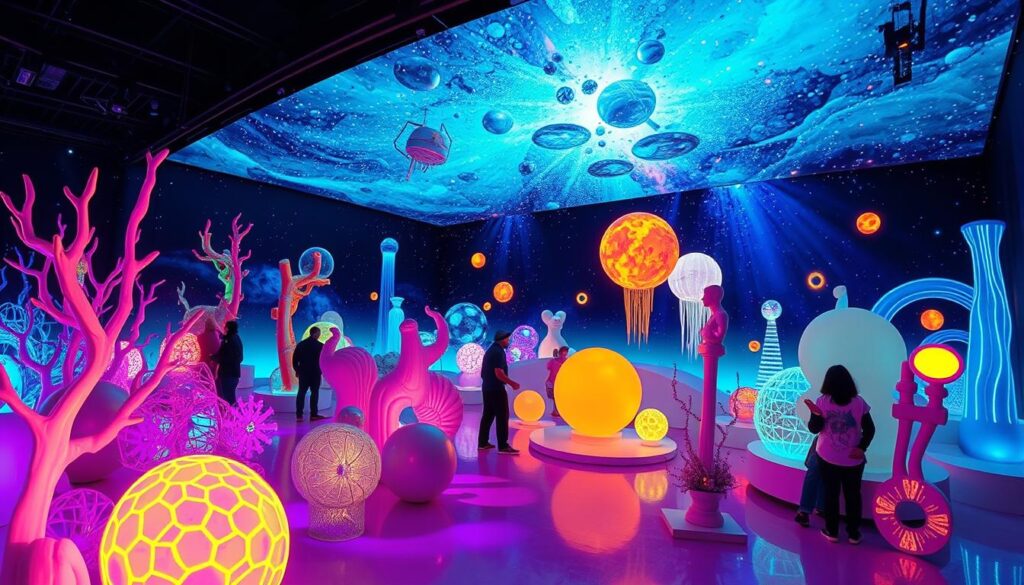
Seismique in Houston folds neon wonder into rooms that feel alive the moment you step inside.
Quick facts: about 40,000 square feet, tickets start near $30, and a glow bar called DRINQUE even lights its pool table.
You’ll move through vivid color fields and reactive rooms that shift as you cross thresholds. The venue hides the machine logic so effects feel magical. Some spaces deliver quick hits. Others slow down so details reveal themselves over time.
- Great for groups—plan a route and mark must-see rooms.
- Flexible capacity keeps lines moving on busy weekends.
- Local artists appear in select wings, adding regional flavor.
- Bring a charger and wear comfortable shoes; you’ll cover ground fast.
| Feature | Why it matters | Visitor tip |
|---|---|---|
| DRINQUE glow bar | Rest point and lighting study | Use as a cooldown between intense rooms |
| Reactive rooms | Playful technology with hidden machine work | Let yourself linger to spot layered details |
| Mixed-scale installations | Combines large rooms with tight vignettes | Observe for project ideas if you design sets |
“Seismique proves bold color and clever tech can make time feel elastic.”
The Friends Experience: Step Onto Iconic Sets in New York City and Beyond
The Friends Experience turns TV nostalgia into a hands-on photo visit for casual fans and superfans alike. You step into Central Perk, Rachel and Monica’s apartment, and more. The set detail is meticulous, so close-ups reward longtime viewers.
You’ll get access to photo stations with pro lighting, so even quick snaps look polished for social media. Timed entry keeps rooms calm and gives your group space to enjoy each beat.
Practical tips: assign a photographer for family groups so everyone cycles through iconic moments. Build time for the store—props and costumes elevate your photos and your memory.
- If you’re going, pick off-peak weekdays in New York City for shorter lines and easier parking.
- Tell staff if you’re celebrating; they often suggest bonus angles you might miss.
- Keep your phone ready—there are many quick scenes beyond the headline sets.
- Think of this visit as a short course in framing and light; little choices make big photo differences.
“It’s a can’t-miss stop for nostalgia that welcomes newcomers without puzzles or pressure.”
New York City Spotlight: Mercer Labs and Stranger Things NYC
Two very different New York stops show how code and story each make you feel part of the art. Visit both in a day for a tech-forward, story-driven doubleheader that suits mixed groups.
Mercer Labs: AI painting by emotion and evolving VR landscapes
Mercer Labs stages changing exhibitions where technology reacts to you. AI canvases paint based on visitor emotions. VR worlds evolve as more people enter a scene.
You’ll see artists and engineers co-create installations that adapt and feel personal. Preview VR modes if you’re sensitive to motion and pick gentler settings as needed.
Stranger Things: Hands-on access to Hawkins—from topside to the Upside Down
Stranger Things NYC hands you tactile sets from the show. Move from recognizable topside scenes into moody Upside Down portraits.
The venue rewards show knowledge, but it stays fun for newcomers. Staff guide you without heavy instruction so your group can explore at its own pace.
- Pair Mercer Labs with Stranger Things in new york city for contrast: one stop is experimental, the other is IP-driven.
- Plan transit time and prebook to lock in ideal slots in york city.
- Capture wide shots at Mercer Labs, then shoot portraits in the Upside Down for dramatic mood.
- Both sites refresh content often—great reasons to return.
“Expect strong staff support; both venues guide you into interactions without heavy instructions.”
Las Vegas Spotlight: Best Immersive Experiences on the Strip and Beyond
Las Vegas concentrates bold installations and story-led theater so you can taste both discovery and spectacle in one visit.
Start at AREA15: Omega Mart is a surreal market built by over 300 creators. Wander false storefronts, chase hidden portals, and treat every aisle as a playful maze of art and oddities.
Meow Wolf’s Omega Mart inside AREA15
Omega Mart rewards free-roam visitors who like to explore at their own pace. The installations are dense and photo-ready, so bring a charger and expect to spend time finding secret rooms.
Particle Ink: Speed of Dark mixed-reality theater
Particle Ink stages a story-led show that fuses live actors with projection-mapped sets and tracked effects. The result blurs the line between stage and reality, and it feels cinematic in scale.
- Plan hours so you can book Omega Mart early and a Particle Ink show after—timed entries keep gaps short.
- If you love music-driven performance, add a lounge stop to decompress between high-intensity scenes.
- Families should pick earlier time slots; late-night energy skews adult.
- Ride-share drop-offs are efficient—schedule returns to avoid peak closing rush.
“The best nights mix sandbox discovery with a tight, story-led spectacle.”
Practical tip: if you prefer free-roam discovery, let Omega Mart anchor your visit. If you want choreography and tech in sync, Particle Ink is a must-see. Either way, Las Vegas packs contrast into a single night.
Global Inspirations Shaping the Future of Immersive Art
Across the world, festivals and institutions teach practical lessons you can bring home. These stops pair artistic ambition with technical craft. They show how scale, sound, and code become design tools you can reuse in a gallery, pop-up, or brand project.
Notable stops to study:
- teamLab Planets, Tokyo: borderless rooms that react to movement and make visitors feel like co-creators.
- Ars Electronica, Linz: a forum where art, technology, and society meet through exhibits, workshops, and talks.
- MUTEK, Montreal: live electronic music fused with real-time visuals—perfect for performance-driven installations.
- Berlin Atonal: experimental sound in industrial spaces using systems like 4DSOUND to shape volume and direction.
- DARK MATTER, Berlin: light and sound works that reimagine space without heavy scenic builds.
- Japan Media Arts Festival, Tokyo: a cross-section of media—installations, gaming, anime, and awards that spotlight creative risk.
- Microwave Festival, Hong Kong: new media and experimental work presented with clear framing and hands-on demos.
Use these stops as a world tour of concepts. Note how artists and engineers make machines feel poetic rather than flashy. Bring a notebook—each festival hands you ideas for a lean project at home.
“Across the board, machines and people interact fluidly, turning tech into poetry rather than spectacle.”
Design Principles: How to Create Interactive Elements That Captivate
Good design layers small, clear actions so visitors feel confident and curious. Start by naming one role the guest plays. That one line keeps your team focused as you add sensory detail.
Layered interactivity:
Layered interactivity: tactile, visual, auditory, and spatial cues
Begin with a single action per beat. Then add a tactile trigger, a visual cue, and a sound to reinforce the moment.
Use light gradients and directional audio as invisible rails. They guide guests without heavy signage.
Scaling up: large-scale installations that guide flow and discovery
For big rooms, cluster work into zones so discovery is continuous. Think of each zone as a small project with a clear spine you can swap out later.
Prototype with paper, tape, and simple mockups first. Proof the idea before wiring technology into walls.
Safety, accessibility, and dwell time as design KPIs
Measure what matters: track dwell time, return paths, and points where visitors stall. Use that data to remove friction and extend the best moments.
Build accessibility from day one. Clear widths, alternate triggers, and readable contrast let more people join the fun.
- Create interactive resets between intense scenes so cameras adapt and guests rest.
- Test sightlines, surfaces, and heights—safety is a KPI as much as mood.
- Document sketches, CAD, and run-of-show so your team can iterate fast.
| Design Area | Why it matters | Practical tip |
|---|---|---|
| Single-action beats | Keeps guests from feeling lost | Limit to one clear verb per moment |
| Sensor + low-tech mix | Feels magical and reliable | Prototype mechanically before adding software |
| Zoning | Prevents overload in large installations | Cluster work into 3–5 themed zones |
| KPIs | Shows what to improve next | Track dwell time and return rates weekly |
“Design that rewards one clear action and layers subtle cues will keep visitors returning and sharing.”
Brand Playbooks: Immersive Activations That Win Hearts and Feeds
When you design around one clear action, even small brand pop-ups can create outsized buzz.
How it played out in the real world: Coca‑Cola’s United Club lounge at Chicago O’Hare turned a layover into a cozy photo moment. The seasonal Sprite Cranberry set produced 1,200+ shareable photos and steady press attention.
Coca‑Cola at O’Hare: Cozy lounge takeover with shareable 3D sets
Comfort and camera-ready design made waiting feel like an event. Staff cues invited short actions—sip, pose, smile—and that single beat drove both dwell time and media coverage.
JUST Egg Festival Tour: Mobile kitchen, light shows, and media-ready tunnels
JUST Egg met people where they were. A mobile kitchen served conveyor samples. A tunnel of lights and music made tasting feel like a mini festival moment.
- You’re going to see how small footprints deliver big impact when activations match audience context.
- Build your project around one hero action—sip, sample, or step‑through—and design everything to support it.
- Use set lighting for post-ready angles so shares happen without asking.
- Simple machine assists, like conveyors, add motion and delight on a tight budget.
- Measure success with photo counts, dwell time, and opt-ins—not just footfall.
“Warm staff scripts and a clear hero action turn casual visitors into enthusiastic fans.”
Seasonal and Evolving Exhibits: Keeping Audiences Coming Back
Seasonal shifts keep a venue feeling fresh and give visitors reasons to return throughout the year. Small, reliable flips build anticipation and become part of local routines.
Artechouse DC offers a good model. Shows like Pixelbloom in spring and Spectacular Factory for the holidays rotate on a steady calendar. They layer XR scavenger hunts over physical displays so guests explore longer and notice hidden details.
Programming cadence and refresh strategies
Plan predictable drops. Rotate themes on a regular cadence so people plan visits into their seasonal time. Keep one or two anchor rooms steady so orientation stays simple.
- Publish hours and calendar drops early so families and members can schedule visits.
- Treat each flip as a mini project: lock your critical path, then iterate until opening day.
- Use behind-the-scenes media to tease refreshes without spoiling surprises for visitors.
- Light-touch machine learning can personalize scavenger clues for repeat guests over time.
- Offer off-peak perks—early-bird hours, member previews, or family mornings—to spread traffic.
| Strategy | Why it works | Practical tip |
|---|---|---|
| Predictable cadence | Turns visits into seasonal rituals | Announce schedule quarterly |
| Anchor rooms | Keeps orientation stable | Keep 1–2 permanent installations |
| XR scavenger hunts | Extends time on site and reward observation | Layer clues across displays and rooms |
| Behind-the-scenes media | Builds buzz without spoiling reveals | Share short clips and staff stories |
“Rotate thoughtfully: each flip should feel like a small, well-run project that invites repeat visits and deeper discovery.”
Social Media Amplification: Turn Visitors into Advocates
Smart design turns brief seconds of attention into lasting advocacy on social channels. High-performing venues plan camera vantage points, lighting, and flow to encourage user-generated content while avoiding bottlenecks.
Designing “thumb-stop” moments without breaking immersion
Make each beat clear: one action, one reveal, one payoff. Keep moments under 20 seconds so people can capture and post quickly.
Use simple cues—a color change, a moving light, or a guided step—to prompt pause without signage. Reserve a few no-photo pockets so guests can reset and re-enter fully present.
Onsite capture, lighting, and wayfinding for UGC
Set light levels for phone cameras first; that single change raises share rates today. Add subtle floor markers or rails to nudge camera angles without breaking the illusion.
- Build a short, unique project hashtag to gather posts and avoid dilution.
- Use live-preview monitors only where they speed flow; avoid visual clutter.
- Train staff with one-line prompts to unlock better photos at pinch points.
- Test concepts with real people—visitors reveal surprise angles you can’t predict.
“Celebrate creator content on your channels to model what good looks like and inspire the next wave.”
Final note: when you design lighting, wayfinding, and capture points together, people share more. That simple alignment turns visits into lasting word-of-mouth for your installations.
Planning Your Trip: Time, Tickets, and What to Expect
Start with opening hours and timed entry slots, then build the rest of your day around one anchor attraction. That small choice reduces rush and keeps your visit focused.
Hours, peak times, and budget ranges across major venues
Check each venue’s hours before you buy. Many spots use timed entry and limited caps, so a booked slot is worth the peace of mind.
Typical tickets start around $20–$35. Expect premium add-ons at places like Superblue and special rooms at larger venues.
- Plan meals and travel around your anchor slot—this avoids long waits and wasted time.
- Weekday afternoons usually mean fewer people and cleaner photos, especially in york city and other major hubs.
- Festival weekends and special nights can add lines but unlock unique scenes—arrive early for the best slots.
Group visits, events, and accessibility considerations
If you bring a group, assign simple roles: navigator, photographer, and timekeeper. That keeps the project smooth and helps you capture the best moments.
Consider accessibility early. Confirm elevator access, seating pockets, and sensory-friendly times so all visitors can join.
- For families, break the visit into parts with rest stops to keep energy up.
- Have a meet-up plan for maze-like rooms in case people split up.
- Carry a small bag for essentials; many venues prefer compact items for safety.
- Wrap with a nearby snack so you can debrief and relive the best part while it’s fresh.
“Check hours and timed-entry rules first, then plan travel and meals around your anchor experiences.”
Conclusion
You now have a practical map to the best immersive experiences in the world. Use it to spot patterns that matter today and pick one place to start.
Plan a simple route. Check hours and set realistic time so your visit feels calm, not rushed.
Look for how light, sound, and shifted perspective shape reality and guide attention. Note wayfinding, resets between installations, and how music or live beats lift pace.
Turn visits into research for your next project: scout, prototype, test, and iterate. Small teams do well when they focus on one strong room over many small pieces.
Go, observe, and adapt—then open with confidence.
FAQ
What makes an engaging interactive experience different from a regular exhibit?
Engaging installations move you from passive viewing to active participation. They combine responsive environments, multisensory design, and a clear narrative so you touch, move, or decide something that changes the work. That design boosts memory, social sharing, and dwell time.
How should I plan a visit to large-scale installations like Superblue or Meow Wolf?
Check hours and ticket options in advance, especially for peak times and special events. Arrive early to avoid crowds, allow extra time for exploration, and bring a fully charged phone for photos and AR components. Consider group tickets if you’re coming with friends or a small business team.
Are these venues accessible for people with mobility needs?
Most major venues such as AREA15, WNDR Museum, and Wonderspaces publish accessibility info on their sites. Look for elevator access, seating, sensory-friendly hours, and staff assistance. Contact the venue ahead of your visit to confirm accommodations.
Can I use my phone or camera inside these attractions?
Yes—many installations encourage photo and social media sharing and provide photo-ready highlights like the Paradox Museum’s Zero Gravity Room. Follow onsite rules: some rooms restrict flash, tripods, or video for safety or to protect the art.
How do designers create installations that boost social sharing and media coverage?
Designers plan “thumb-stop” moments with bold visuals, layered interaction, and clear wayfinding. They also optimize lighting and affordances for user-generated content (UGC) so visitors can easily capture shareable photos and short videos.
What should small businesses know about producing immersive brand activations?
Start with a tight concept tied to your product or story. Focus on layered sensory cues, safety, and measurable KPIs like dwell time and social impressions. Partner with local artists or tech teams to scale installations within budget.
Are there family-friendly or kid-focused options among these attractions?
Yes. Venues like City Museum in St. Louis and family programs at Meow Wolf offer hands-on, playful elements suited to kids. Check age recommendations and height or safety restrictions before visiting.
How much do tickets typically cost for these attractions?
Prices vary by city and venue. Expect a range from affordable local museum entry to premium-priced large-scale shows. Many places offer discounted daytime slots, student or group rates, and special passes for multiple visits.
What role does technology play in modern immersive art?
Technology—from VR and AR to motion sensors, projection mapping, and real-time sound design—enables responsive, evolving installations. It helps create narrative depth and dynamic encounters that feel like stepping into another world.
How often do exhibits change or rotate at places like Wonderspaces or AREA15?
Many venues rotate exhibits seasonally or quarterly to keep offerings fresh. Traveling shows and festival tie-ins also mean you’ll often find new artists and limited-time installations throughout the year.
Can I host a private event or brand activation inside these spaces?
Yes—venues such as AREA15 and Superblue frequently host private events, launches, and brand activations. Reach out to their events team to discuss capacity, technical needs, and custom programming.
What are common safety considerations for large-scale, touchable installations?
Safety includes clear signage, supervised zones for active elements, non-slip flooring, regular sanitation, and limits on occupancy for small rooms. Designers also factor in accessibility and emergency egress into the layout.
How can I discover new immersive shows in my city or while traveling?
Follow venue newsletters and social channels, check ticket platforms, and monitor festivals like MUTEK or Ars Electronica for touring exhibits. Local arts calendars and tourism sites also list seasonal and pop-up installations.
Do museums and installations offer sensory-friendly or quiet hours?
Many do. Institutions increasingly schedule quiet or low-sensory sessions for visitors with neurodiverse needs. Look for dedicated time slots on the venue’s ticket page or contact the box office for details.




